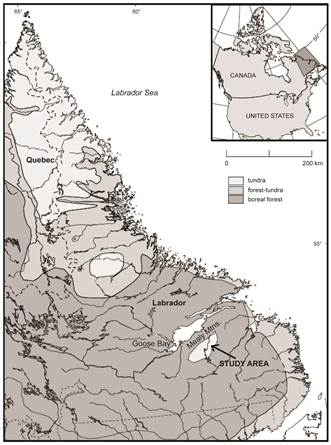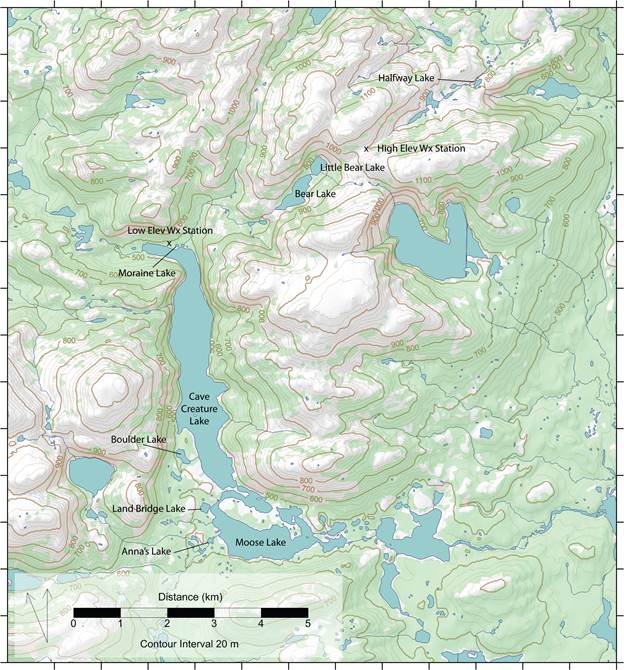Reports: UNI253378-UNI2: Controls on Organic Carbon Accumulation, Burial Efficiency, and Hydrocarbon Content in Lake Sediments of the Boreal Forest-Tundra Ecotone, Labrador, Canada
Timothy L. Cook, PhD, Worcester State University
Despite covering only a fraction of the Earth’s surface, lakes are a disproportionately large reservoir of organic carbon in the global system. Consequently, lakes play an important role in the modern carbon cycle and ancient lacustrine source rock are increasingly being utilized as petroleum resources. This study is examining a network of modern lakes which span the dramatic ecological gradient of the boreal forest-tundra ecotone in southeastern Labrador, Canada (Figure 1). By quantifying rates of organic carbon accumulation and burial efficiency in lakes of differing physical characteristics and ecological surroundings the project aims to evaluate the effects of differing within-lake processes, watershed characteristics, and long-term climate and environmental changes on the accumulation of organic carbon in lacustrine environments.
Figure 1. Regional map of Labrador indicating dominant vegetation zones. The study location along the eastern edge of the Mealy Mountains occurs at the transition between tundra and forested vegetation.
The first year of this project was focused on organizing and carrying out a field expedition to the eastern Mealy Mountains in southeastern Labrador, Canada. During July and August of 2014 the PI and two undergraduate field assistants, Daniel Cronin from Worcester State University, and Timothy Campbell from Bates College spent 18 days at a remote camp that we established on the shore of Cave Creature Lake and accessed via float plane from Happy Valley-Goose Bay Labrador (Figure 2). This rugged area is dotted with lakes of various shapes and sizes and spans the boundary between boreal forest and tundra biomes making it an ideal natural laboratory. As the region sees few visitors and has been the focus of very little scientific attention, our first field season entailed significant exploration of overland routes between lakes and basic surveying of lake characteristics. In total we completed bathymetric surveying and evaluated water column properties of 9 lakes in order to characterize modern physical and chemical characteristics of the lakes (Table 1). Surface grab samples and/or long sediment cores were then collected from each lake to quantify differences in the organic carbon content of sediments. In addition, we deployed moorings in each lake which include automated temperature loggers placed at various depths throughout the water column and bottom sediment traps. Moorings will be recovered during the 2015 summer field season and their data used to better define differences in physical characteristics and mixing processes within the lakes and to determine annual rates of organic carbon deposition. The final aspect of the field work involved in-situ experiments to quantify rates of primary productivity in two of the lakes, Bear Lake and Boulder Lake, which were deemed likely to represent end members on the spectrum of productivity.
Figure 2. Map of field study area in the eastern Mealy Mountains in southeastern Labrador, Canada depicting the various lakes targeted during the 2014 field campaign.
Table 1. List of lakes surveyed during 2014 field campaign.
The undergraduate students who participated in the field work remain heavily involved in the project and both will be completing senior theses utilizing samples or data collected during the summer. Timothy Campbell is focusing on the two longest sediment cores which preliminarily appear to extend through the entire post glacial lacustrine sequence of the region. He will be using these cores to evaluate the long-term variability of organic carbon accumulation during this period of significant climate and environmental change. Daniel Cronin is focusing on a comparison of the modern environments of the different lakes, utilizing field observations, GIS data, and remote sensing observations to distinguish the primary physiographic differences among the lakes and explain the resultant biological, chemical, and sedimentary characteristics. Both students plan to present the results of their work at the upcoming Geological Society of America Northeastern Section Annual Meeting in March 2015.
The supported project is advancing the PI’s research into a new geographic region and offers new insight into the mechanisms that connect physical, biological, and chemical processes in lakes to the formation of distinct sedimentary deposits. During the preparation and carrying out of field work the PI developed new lightweight field sampling equipment which were critical to the success of the field campaign and which will open up new opportunities for carrying out additional studies in other remote locations in future. The preliminary reconnaissance work conducted during year one of this project has provided considerable insight into the range of variability of lakes within this concentrated study area. Continued analysis of samples collected in the field will help constrain the long-term climatic and environmental history of the region which is largely unknown at this time. With the recovery of the moorings and additional, targeted coring during the summer of 2015 we plan to fully explore connections between the differing lakes and their varying rates of organic carbon accumulation and burial efficiency.













